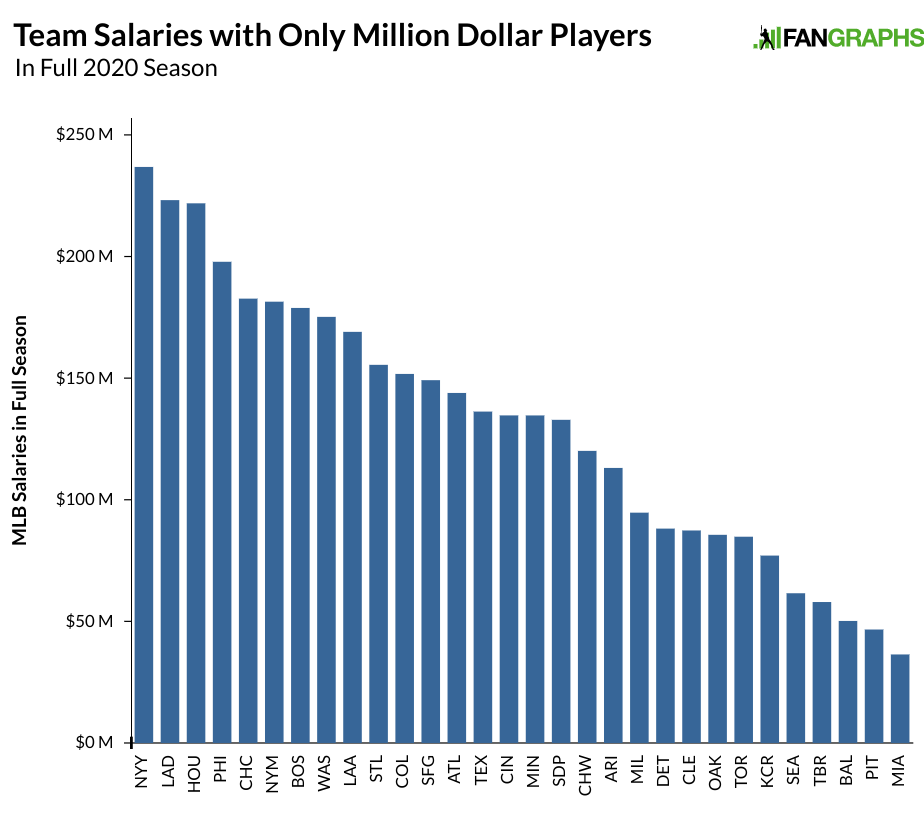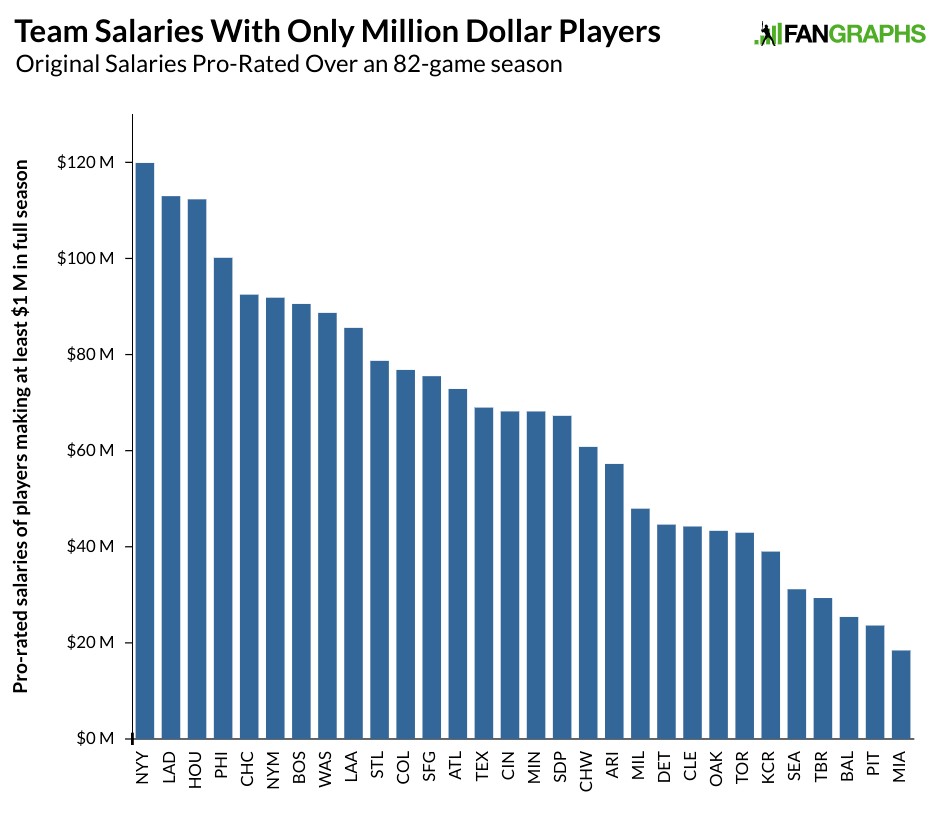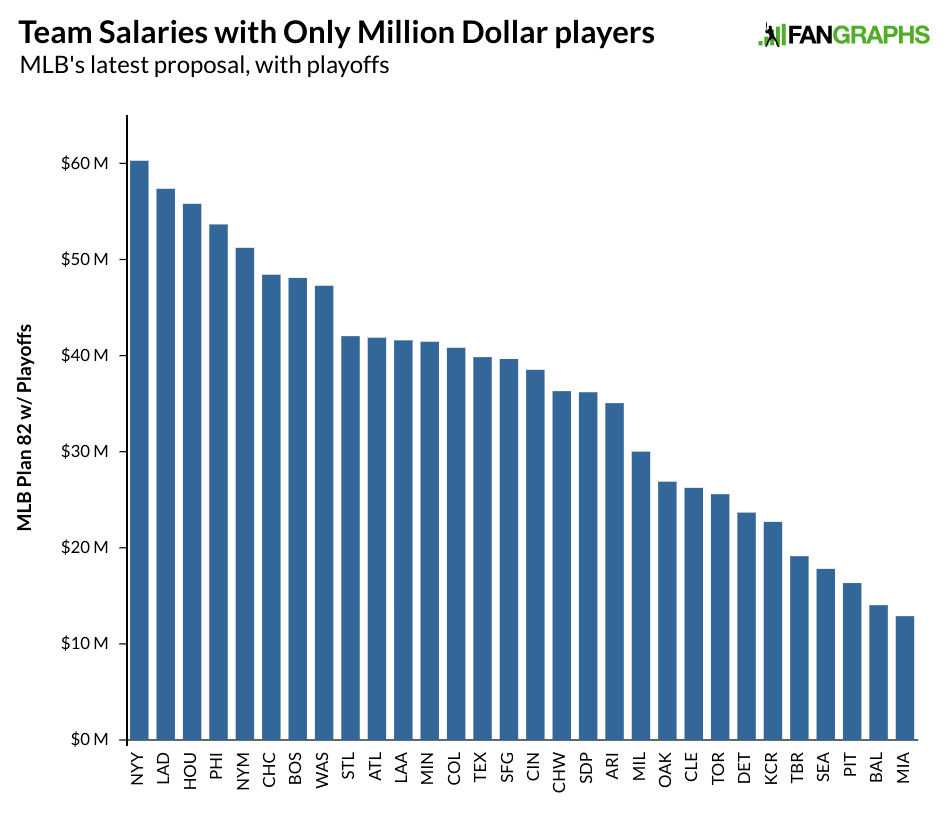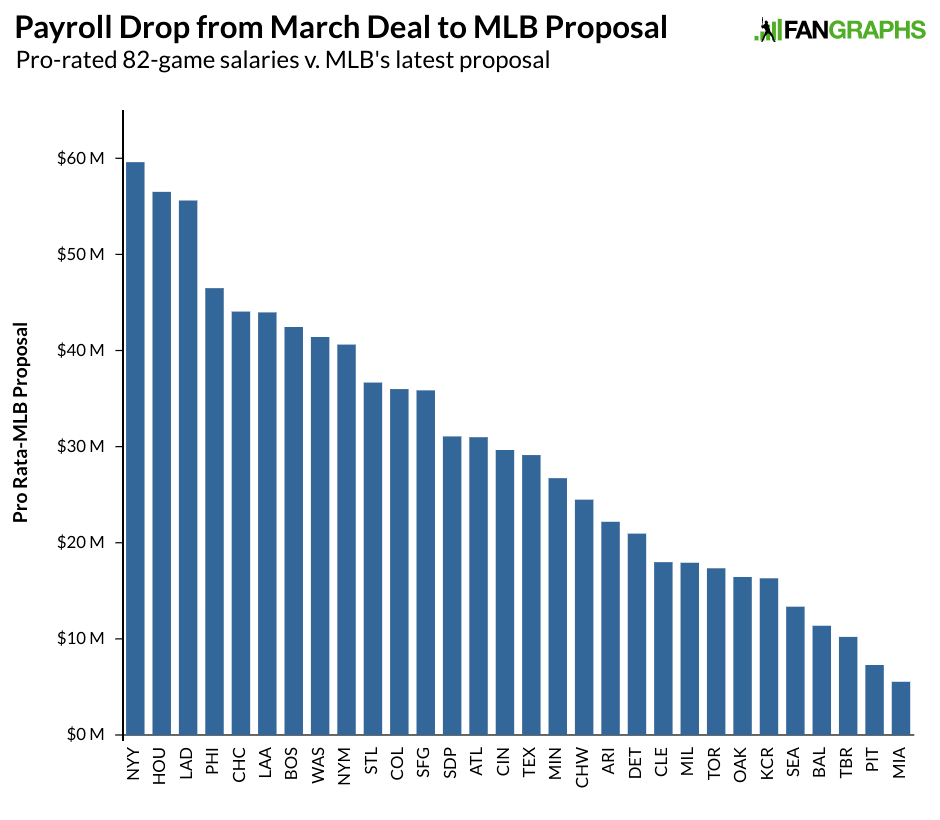MLB’s Latest Proposal Caters to Its Richest Teams
Much of the focus regarding baseball’s potential return has centered on whether the players and owners can come to a financial agreement both parties feel works for them. The two groups may negotiate as cohesive units, but they are comprised of distinct individuals and entities that often have diverging interests. The league’s proposal appears to have been an attempt to drive a wedge between the highest earners in the sport and those making closer to MLB’s league minimum. And while Rob Manfred needs to find a solution that players will agree to, before he can even make such an offer, his proposal has to fly with his 30 bosses, the MLB owners. Those owners don’t always have the same goals or ideas about how the business of baseball should be run – the league’s latest proposal reflects those differences, as big-market teams received the biggest benefit.
A few weeks ago, Ken Rosenthal and Evan Drellich reported in The Athletic that baseball’s traditional revenue sharing was at risk in 2020. Local television money is big for teams in this era, and the gap between the top 10 teams in television revenue and the bottom 10 is, on average, $67 million even before accounting for network ownership. Attendance and stadium-related revenue tends to further exacerbate that gap. Revenue sharing, where each team pools together 48% of local revenue and divide it equally, shrinks the gap some, but still provides the big-market, high-revenue teams a significant advantage. With most stadium-related revenue potentially gone, the divide gets a bit skinnier. From the Drellich and Rosenthal piece:
“The discrepancy between the Rays and the Red Sox this year is not that dramatic,” the executive said. “It’s still money. It’s tens of millions of dollars. But it’s not hundreds of millions of dollars. And if you’re going to share that, it’s not going to move the needle enough this year.”
MLB’s presentation to the players regarding team losses had some fairly significant holes, but it did show the traditional big moneymakers like the Yankees and Dodgers suffering the biggest losses. Lost stadium revenue drives some of that, but high payrolls contribute as well. Those high payrolls are normally easily justified by massive revenues, but if team revenues were the same, the higher payroll clubs would be more likely to lose money. MLB’s latest proposal attempted to do those clubs a huge favor.
To provide some sense of the typical payroll gap between teams, the graph below shows only salaries of $1 million or more projected in the original 2020 season:

We see a huge spread between the top and bottom teams, which is fairly typical over the last few years. Here’s what the same graph looks like with pro-rated salaries over an 82-game season:

The second graph is basically the first one divided in half. These aren’t full payrolls because we’d need to add in all the minimum-salaried players, but the differences you see are pretty close to the total numbers. MLB’s latest proposal hits the highest-salaried players the hardest, and the teams that pay the higher-salaried players tend to have the larger payrolls. Here’s what would happen to team payrolls under MLB’s latest offer, including only players originally scheduled to make $1 million or more in a full season. The $200 million for playoffs is included in the figures below:

We see these salaries bundled more in the middle. MLB’s proposal dropped these players’ salaries by 45% compared to a pro-rated 82-game season, but the standard deviation of these salaries dropped by 53%. The graph below shows the changes in each team’s payroll from the March agreement with pro-rated salaries to MLB’s latest proposal:

Those teams on the left have the most to gain under MLB’s latest proposal, while those teams on the far right barely see any change to payroll at all. It’s not hard to identify the types of teams in each group. We have the Yankees, Astros, Dodgers, Phillies Cubs, Angels, and Red Sox leading the way with salary cuts while the Marlins, Pirates, Rays, Royals, and A’s are all near the bottom in terms of change. To illustrate the change a little more, here’s a scatter plot showing the change above with Forbes valuations:

There’s a pretty strong relationship here (the R-squared =.57) and a lot of that is because rich teams spend more. In MLB’s latest proposal, those same rich team receive the biggest benefits. It’s the owners’ of trying to share the lost revenue, except instead of doing it amongst themselves, they are hoping that the players will do it for them. It’s a way that prevents some potentially difficult conversations between Rob Manfred and the owners. If the union response is any indication, the owners are going to need to have some of those difficult conversations in the coming days if they want to have a 2020 baseball season.
Craig Edwards can be found on twitter @craigjedwards.

Nice work, Craig. I just broke down the potential Tigers’ payroll using a prorated 82 game schedule as well as the owners’ proposed (non starter) plan. Without Prince Fielder’s final $6M payment, they come in under $50M on a prorated deal and just $21.4M under the owners’ plan.
https://www.blessyouboys.com/2020/5/28/21273605/mlb-salary-proposal-pay-cuts-mlbpa-shortened-season
There is no way that the team would lose money by playing games on an 82 game schedule with prorated salaries. In fact, MLB overall would make more money by playing the games than not. Their claims to the contrary are simply not true.
Player salaries total under $4 billion, and would be under $2 billion if prorated for 82 games. We don’t know the contract details with the networks in the event of a partial season or no season, but they would have more than enough revenue from national and local media sources even with no attendance or other stadium related revenue, and half of those media revenues.
Scott Boras may be right that the owners want to pawn off losses due to loan payments for their real estate deals, but they’re not losing money by playing baseball, and they won’t open the books to show otherwise.
Took a quick look at your site where you site an AP article where MLB claims that the Detroit Tigers will lose $84M (negative EBITDA) and this is the lowest loss amongst all MLB teams (Yankees most at $312M since they funded their own stadium) based only on pro-rating salaries. Where do you get from this that the Tigers will not lose money by not having the players taking any additional hit from no audience? MLB’s -$84M estimate seems high since the Tigers’ payroll (Miggy & Jordan Zimmerman, yuck!) is low and their expected stadium receipts were low too, though maybe they were expecting a big loss had 2020 proceeded normally, since teams often lose money when they’re bad. In other words, what revenues (local TV + revenue sharing) are you expecting for the Tigers?
Craig’s article is interesting but he seems to want to dis-incentivize teams from carrying high payrolls. “These teams are getting all the relief and it’s not fair!”, seems to be his argument. I thought Craig and most Fangraphs’ readers wanted all teams to have high payrolls (cuz that’s how you win!, apparently) and now Craig wants to penalize these high rollers during a nationwide emergency.
I don’t think a divide-and-conquer-the-owners strategy is going to work since it seems to be NYY, LAD, BOS that are most in favor of Manfred’s proposal. Alienate them and there ain’t going to be a season.
Good points. You’re always open minded and engaging. It seems the rich man, poor man narrative fits for both players and owners. But we knew this going into the next CBA. The players salary disparity is easier to fix than the owner disparity. I say this because fans are what baseball is about. Both owners and players are nothing without their customers. Unlike the NBA and NFL local revenues fund the MLB game. This means rich team fan bases disproportionately fund the game. I wish MLB had big national television contracts, but they don’t…